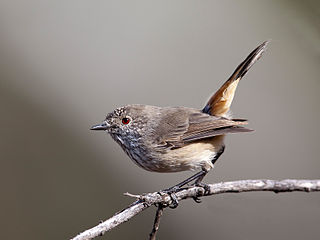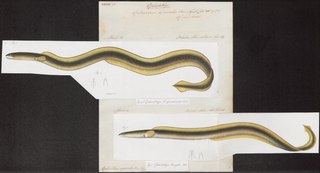
The dibbler is an endangered species of marsupial. It is an inhabitant of the southwest mainland of Western Australia and some offshore islands. It is a member of the order Dasyuromorphia, and the only member of the genus Parantechinus. The dibbler is a small, nocturnal carnivore with speckled fur that is white around the eyes.

Leporillus is a genus of rodent in the family Muridae endemic to Australia. It contains the following species:

The inland thornbill was originally described by English ornithologist John Gould in The Birds of Australia. Inland thornbills are within the order passerines. The inland thornbill belongs to the genus Acanthiza, which now has three more species than the eleven outlined by Gould in The Birds of Australia. The Noongar people of southwestern Western Australia call A. apicalis "Djoobi-Djoolbang". The inland thornbill is also known as the broad-tail thornbill and presently contains several subspecies that were once considered independent species. The word apicalis comes from the Latin for 'tipped'.
Beringa Reserve, formerly known as Peniup Creek Reserve, is a 25.06 km2 nature reserve in south-west Western Australia. It lies about 380 km south-east of Perth. It is owned and managed by Bush Heritage Australia (BHA), by which it was purchased jointly with Greening Australia (WA) in 2007, and forms part of the Gondwana Link project, in which BHA is a partner.

Nectomys apicalis, also known as the western Amazonian nectomys, is a semiaquatic species of rodent in the genus Nectomys of family Cricetidae. It is found east of the Andes in Ecuador, Peru, and Bolivia, east into western Brazil; further to the east, it is replaced by N. rattus. It lives near watercourses in lowland tropical rainforest. Its karyotype has 2n = 38–42, and it probably actually represents several distinct undescribed species.
Madaglymbus apicalis is a species of diving beetle. It is part of the genus Madaglymbus in the subfamily Copelatinae of the family Dytiscidae. It was described by Fairmaire in 1898. Madaglymbus apicalis is distributed along the coastlines of much of Africa.

Mimacraea apicalis, the central acraea mimic, is a butterfly in the family Lycaenidae. It is found in Nigeria, Cameroon, Gabon and the Republic of the Congo.

Dindicodes apicalis is a moth of the family Geometridae first described by Frederic Moore in 1888. It is found in Asia, including India and China.

The bluntnose snake eel is an eel in the family Ophichthidae. The author of the species is anonymous, but it has been referred to Edward Turner Bennett in 1830. It is a tropical, marine eel which is known from the Indo-Pacific, including Kenya, Madagascar, South Africa, Taiwan, Thailand, and the Philippines. It dwells at a maximum depth of 22 m, but also frequents shores. Males can reach a maximum total length of 45 cm.
Anagelasta is a genus of longhorn beetles of the subfamily Lamiinae, containing the following species:
Anagelasta grisea is a species of beetle in the family Cerambycidae. It was described by Stephan von Breuning in 1936. It is known from India.
Anagelasta lineifrons is a species of beetle in the family Cerambycidae. It was described by Gressitt in 1951. It is known from China.
Anagelasta nigromaculata is a species of beetle in the family Cerambycidae. It was described by Stephan von Breuning in 1938. It is known from India.
Anagelasta transversevittata is a species of beetle in the family Cerambycidae. It was described by Stephan von Breuning in 1964. It is known from Laos.
Anagelasta trimaculata is a species of beetle in the family Cerambycidae. It was described by Stephan von Breuning in 1938. It is known from India.

Disparoneura apicalis, black-tipped bambootail is a damselfly species in the family Platycnemididae. It is endemic to Western Ghats. It was described from Kodagu, Karnataka, on the upper reaches of the Kaveri River. It is also found to occur in Kuruvadweep, Wayanad, Kerala, along the banks of Kabini River.

Glenea apicalis is a species of beetle in the family Cerambycidae. It was described by Louis Alexandre Auguste Chevrolat in 1857, originally under the genus Saperda. It has a wide distribution in Africa. It feeds on Hibiscus rosa-sinensis.
Linda apicalis is a species of flat-faced longhorn in the beetle family Cerambycidae. It is found in China, including Tibet.







